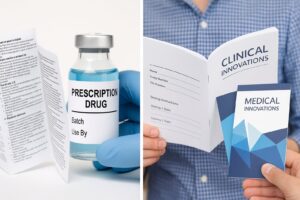Essential Print Products for Pharmaceuticals
Why printed materials still matter in a highly regulated, digital-first world.
Everyone in pharma knows the paperwork never ends—but not all of it lives on a screen.
Printed materials remain absolutely essential, from safeguarding patients to meeting supply chain compliance.
Whether it’s a multilingual leaflet folded into a box, or a clinical trial booklet handed to participants, the printed word still carries authority – and responsibility.
But in this context, print needs to meet much higher standards.
Every item must meet strict standards for accuracy, clarity, durability, and format.
Patient Information Leaflets: Clarity, Compliance, and Format
Patient information leaflets (PILs) are among the most regulated print products in the pharmaceutical space.
Patient information leaflets are legally required for most licensed medicines in the UK and EU under MHRA and EMA regulations.
Regulators scrutinise them closely—not just at the point of approval, but whenever important updates are made after a product reaches the market.
They may not be reviewed as intensely as the drug itself—but they’re still considered a critical part of the product’s safety profile.
They must be:
- Clear, readable layouts
- Accurate, approved translations
- Consistency across all versions (*)
- Folding styles that fit neatly into packaging
- Paper stocks that won’t smudge or degrade
(*) Consistency across all versions means ensuring every leaflet—regardless of language, format, batch, or pack size—contains accurate, up-to-date information that matches the approved version exactly.
And all of that must be managed while ensuring that every printed leaflet reflects the most up-to-date, approved version—regardless of language, batch, or format.
It’s a real test of process and precision—something trusted print providers to the pharmaceutical sector are expected to deliver without fail.
Labels and Packaging Stickers: Small Surface, Big Responsibility
Labels may be small, but their role is anything but.
A pharmaceutical label isn’t just a sticker—it’s a critical point of safety, traceability, and compliance.
Whether they’re going on bottles, blister packs, cartons or refrigerated containers, they must perform under pressure—literally and figuratively.
Key requirements include:
- Expiry dates that must be accurate and clearly visible
- Batch numbers for traceability and recalls
- Durability, including waterproof, smudge-proof, or cold-storage-resistant materials
- Legibility even on small packaging or curved surfaces
The challenge?
It’s keeping things consistent across multiple formats and languages, especially when batches change or product specs are updated at short notice.
The real challenge is keeping things consistent across multiple formats, especially when batches change or product specs are updated at short notice.
Clinical Trial Materials: Supporting Research with Accuracy
Clinical trials bring a unique set of print demands.
From participant instruction cards to protocol booklets and drug labelling, every printed item must be accurate, consistent, and aligned with good clinical practice.
Print needs to support both compliance and participant understanding—with no room for misinterpretation.
Typical requirements include:
- Booklets outlining trial protocols and participant responsibilities
- Instruction cards for home use or repeat dosage reminders
- Custom labels for investigational products, with strict controls on wording and layout
- Participant diaries or record sheets for tracking results.
Because trial materials often vary slightly between phases or trial arms, version control is critical. A misprinted instruction could lead to non-compliance, skewing trial results or even compromising participant safety.
That’s why pharmaceutical firms look for printing partners who can handle complexity, track every file revision, and work to tight approval workflows without missing a step.
Marketing Materials: Professional, Consistent, and Compliant
Pharmaceutical sales teams still rely heavily on printed materials—especially for face-to-face meetings, conferences, or leave-behind packs.
But unlike consumer marketing, pharma marketing is tightly controlled. That means the design and messaging must walk a fine line.
Common marketing print items include:
- Product brochures for healthcare professionals
- Presentation folders to keep information organised
- Flyers or leaflets for in-practice distribution
- Leave-behinds. Concise, compliant materials that sales reps leave with healthcare professionals to reinforce key messages
Everything must reflect brand professionalism, while also adhering to the rules set out by regulatory bodies such as the ABPI (in the UK) or similar frameworks elsewhere. In short: smart design, without stepping over the line.
Why It All Comes Down to the Right Print Partner
Every printed item in the pharmaceutical industry—from the tiniest label to the most detailed trial document—must be right first time. There’s no room for second chances.
That’s why companies providing print services for pharmaceutical companies need to deliver more than just sharp visuals—they need to be reliable, repeatable, and regulation-ready.
They demand:
- Deep understanding of compliance and documentation standards
- Secure file handling and version control
- Multilingual typesetting expertise
- Consistent delivery, even at scale
- The ability to flag potential issues before they become costly problems
Because when patient safety is at stake, “good enough” simply isn’t.
If you’d like to find out more, please get in touch here.



